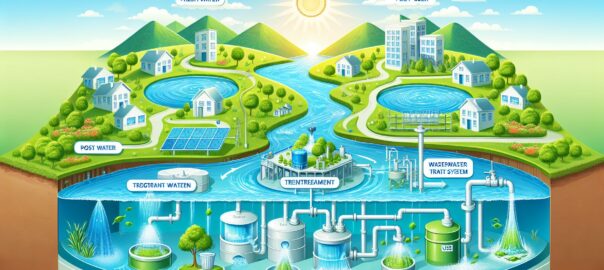Water scarcity and pollution are critical challenges that our world faces today. As urban populations continue to grow, the pressure on existing water infrastructure intensifies, necessitating efficient and sustainable wastewater management solutions. An Integrated Wastewater Treatment System (IWTS) is a holistic approach aimed at addressing these challenges by combining advanced technologies, ecological principles, and effective management practices. This article delves into the significance of IWTS, exploring its components, benefits, and implementation strategies, as well as examining case studies that exemplify its positive impact on the environment and society.
What is an Integrated Wastewater Treatment System?
An Integrated Wastewater Treatment System is a comprehensive framework that encompasses the collection, treatment, and reuse of wastewater within a single, cohesive operation. In contrast to conventional segmented processes, IWTS strives to create a seamless interaction between various wastewater management phases to achieve optimal efficiency, reduce pollution, and conserve water resources.
Components of IWTS
The integrated system typically consists of the following components:
-
Wastewater Collection System: The network of pipes and conduits that transport wastewater from residential, commercial, and industrial sources to the treatment facilities.
-
Preliminary Treatment Facilities: Structures that remove large debris and grit from wastewater to prevent damage to subsequent treatment units.
-
Primary Treatment Units: Tanks and clarifiers that facilitate the settling of solids and separation of organic matter.
-
Secondary Treatment Processes: Biological treatment methods, such as activated sludge systems, which degrade organic pollutants.
-
Tertiary Treatment Methods: Advanced treatment technologies, including filtration and disinfection, to further purify the wastewater to meet specific reuse or discharge standards.
-
Sludge Treatment and Disposal: The processing of biosolids separated during treatment for safe disposal or beneficial use.
-
Effluent Reuse Facilities: Systems for recycling treated wastewater for non-potable applications, such as irrigation or industrial cooling.
-
Monitoring and Control Systems: Sensors and automated controls that allow for real-time surveillance and management of the treatment processes.
-
Data Integration and Analytics: Software platforms that aggregate and analyze data from different stages of treatment to optimize system performance.
Benefits of Integrated Wastewater Treatment
The integration of wastewater treatment components yields a range of ecological, economic, and social benefits:
-
Environmental Sustainability: By promoting effluent reuse, IWTS reduces the extraction of freshwater from natural sources, preserving ecosystems and biodiversity.
-
Resource Recovery: Integrated systems can recover nutrients, energy, and water from wastewater, turning waste into valuable resources.
-
Cost-Efficiency: A well-designed IWTS minimizes operational costs by streamlining processes and reducing the need for extensive infrastructure.
-
Regulatory Compliance: Advanced treatment methods ensure that the effluent meets stringent environmental regulations, thus avoiding penalties and preserving public health.
-
Community Engagement: Public awareness and involvement in wastewater management can be enhanced through educational programs, fostering a sense of stewardship and cooperation.
Implementing an Integrated Wastewater Treatment System
The successful implementation of an IWTS involves several critical steps:
-
Planning and Design: Comprehensive assessment of local needs, resource availability, and regulatory frameworks to create an effective and sustainable system design.
-
Technology Selection: Choosing appropriate treatment technologies that align with specific water quality goals, budget constraints, and operational preferences.
-
Construction and Commissioning: Building the infrastructure in accordance with the design specifications and initiating operations with thorough testing and calibration.
-
Training and Capacity Building: Ensuring that personnel are adequately trained to operate and maintain the system for optimal performance.
-
Monitoring and Optimization: Utilizing data analysis tools to continually assess system efficiency and make adjustments as necessary.
Case Studies of Successful IWTS Implementation
Singapore’s NEWater Program
Singapore’s limited water resources and growing demand led to the development of the NEWater program, which treats reclaimed water to ultra-clean, high-grade reclaimed water. The program’s integrated approach involves advanced membrane technologies and ultraviolet disinfection, contributing to the nation’s water sustainability goals.
Orange County Water District’s Groundwater Replenishment System
The Groundwater Replenishment System in Orange County, California, is one of the largest water recycling projects in the world. Employing microfiltration, reverse osmosis, and advanced oxidation, the system produces water that exceeds drinking standards and replenishes local groundwater supplies.
Challenges and Solutions in Wastewater Integration
The transition to IWTS is not without hurdles, such as high capital costs, complex technology integration, and public resistance to using reclaimed water. Addressing these challenges requires:
-
Innovative Financing: Exploring public-private partnerships, grants, and green bonds to fund infrastructure projects.
-
Stakeholder Collaboration: Engaging with regulators, industry leaders, and the community to align interests and secure support.
-
Education and Advocacy: Promoting the benefits of wastewater reuse and dispelling misconceptions about treated effluent.
Conclusion
Integrated Wastewater Treatment Systems represent a forward-thinking solution to current and future water management challenges. By combining technology, ecology, and effective governance, these systems provide a pathway to sustainable development and environmental conservation. As water scarcity intensifies across the globe, the adoption of IWTS will become increasingly crucial for ensuring the resilience of urban infrastructure and the well-being of human societies.
Sources
-
United States Environmental Protection Federation. (2023). Wastewater Technology Fact Sheet: UV Disinfection. Retrieved from https://www.epa.gov
-
Orange County Water District. (2023). Groundwater Replenishment System. Retrieved from https://www.ocwd.com/gwrs/
-
Public Utilities Board Singapore. (2023). NEWater. Retrieved from https://www.pub.gov.sg/watersupply/fournationaltaps/newater
The structured integration of wastewater treatment and the efficient use of water resources provided by IWTS contribute not only to environmental sustainability but also to socio-economic growth. They are essential in addressing the water-related challenges of the 21st century, ensuring a secure and prosperous future for generations to come.
